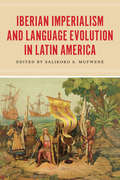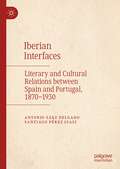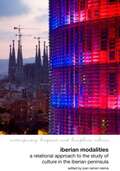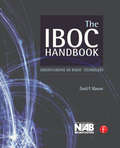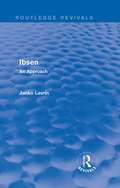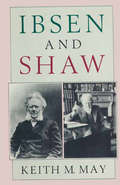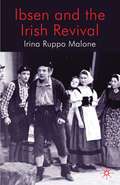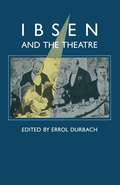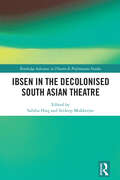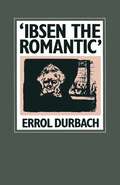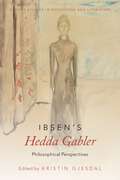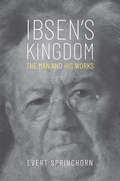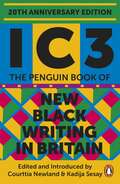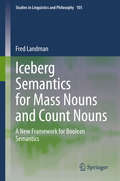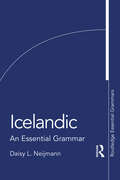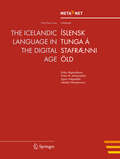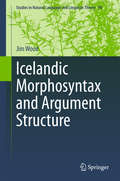- Table View
- List View
Iberian Imperialism and Language Evolution in Latin America
by Salikoko S. MufweneAs rich as the development of the Spanish and Portuguese languages has been in Latin America, no single book has attempted to chart their complex history. Gathering essays by sociohistorical linguists working across the region, Salikoko S. Mufwene does just that in this book. Exploring the many different contact points between Iberian colonialism and indigenous cultures, the contributors identify the crucial parameters of language evolution that have led to today’s state of linguistic diversity in Latin America. The essays approach language development through an ecological lens, exploring the effects of politics, economics, cultural contact, and natural resources on the indigenization of Spanish and Portuguese in a variety of local settings. They show how languages adapt to new environments, peoples, and practices, and the ramifications of this for the spread of colonial languages, the loss or survival of indigenous ones, and the way hybrid vernaculars get situated in larger political and cultural forces. The result is a sophisticated look at language as a natural phenomenon, one that meets a host of influences with remarkable plasticity.
Iberian Imperialism and Language Evolution in Latin America
by Salikoko S. MufweneAs rich as the development of the Spanish and Portuguese languages has been in Latin America, no single book has attempted to chart their complex history. Gathering essays by sociohistorical linguists working across the region, Salikoko S. Mufwene does just that in this book. Exploring the many different contact points between Iberian colonialism and indigenous cultures, the contributors identify the crucial parameters of language evolution that have led to today’s state of linguistic diversity in Latin America. The essays approach language development through an ecological lens, exploring the effects of politics, economics, cultural contact, and natural resources on the indigenization of Spanish and Portuguese in a variety of local settings. They show how languages adapt to new environments, peoples, and practices, and the ramifications of this for the spread of colonial languages, the loss or survival of indigenous ones, and the way hybrid vernaculars get situated in larger political and cultural forces. The result is a sophisticated look at language as a natural phenomenon, one that meets a host of influences with remarkable plasticity.
Iberian Interfaces: Literary and Cultural Relations between Spain and Portugal, 1870-1930
by Antonio Sáez Delgado Santiago Pérez IsasiThis book explores a key historical moment for literary and cultural relations between Spain and Portugal. Focusing on the period between 1870 and 1930, it analyses the contacts between Portuguese and Spanish writers and artists of this period, showing that, at least among the cultural elites, there were intense and fruitful dialogues across political and linguistic borders. The book presents the Iberian Peninsula as a complex and multilingual cultural polysystem in which diverse literary cultures coexist and are mutually dependent upon each other. It offers a panoramic view of Iberian literary and cultural history, encompassing not just Portuguese and Spanish literary productions, but also Catalan, Galician and Basque works. Combining a clear theoretical foundation with deep historical knowledge and references to specific texts and works, the book offers a thorough introduction to Iberian literature in the late nineteenth and early twentieth century.
Iberian Modalities: A Relational Approach to the Study of Culture in the Iberian Peninsula (Contemporary Hispanic and Lusophone Cultures #8)
by Joan Ramon ResinaOf late the term Iberian Studies has been gaining academic currency, but its semantic scope still fluctuates. For some it is a convenient way of combining the official cultures of two states, Portugal and Spain; yet for others the term opens up disciplinary space, altering established routines. A relational approach to Iberian Studies shatters the state’s epistemological frame and complexifies the field through the emergence of lines of inquiry and bodies of knowledge hitherto written off as irrelevant. This timely volume brings together contributions from leading international scholars who demonstrate the cultural and linguistic complexity of the field by reflecting on the institutional challenges to the practice of Iberian Studies. As such, the book will be required reading for all those working in the field.
The IBOC Handbook: Understanding HD Radio (TM) Technology
by David P. MaxsonRadio broadcast engineers seeking to design and operate HD Radio(TM) transmission systems will benefit from the detailed exposition of the technology. The book lays out the entire structure of this digital transmission system. System equations are presented in a manner that is useful to those interested in them, while retaining a clear narrative for those who seek a general understanding of how the technology works. The book also presents a summary of the history of the technology and the NRSC-5 standard, as well as forward-looking information on emerging technologies and applications.
The IBOC Handbook: Understanding HD Radio (TM) Technology
by David P. MaxsonRadio broadcast engineers seeking to design and operate HD Radio(TM) transmission systems will benefit from the detailed exposition of the technology. The book lays out the entire structure of this digital transmission system. System equations are presented in a manner that is useful to those interested in them, while retaining a clear narrative for those who seek a general understanding of how the technology works. The book also presents a summary of the history of the technology and the NRSC-5 standard, as well as forward-looking information on emerging technologies and applications.
Ibsen: An Approach (Routledge Revivals)
by Janko LavrinThis book, first published in 1950, could best be described as a combination of literary, psychological and social criticism. Considerable space is allotted to the personal inner drama of Ibsen, which provides not only a clue to his art but shows how most of his themes inevitably grew out of the other. The author also explores some of those factors which make Ibsen of interest to the generation that were facing the social and spiritual havoc of the post-war period. This book will be of interest to students of literature and theatre.
Ibsen: An Approach (Routledge Revivals)
by Janko LavrinThis book, first published in 1950, could best be described as a combination of literary, psychological and social criticism. Considerable space is allotted to the personal inner drama of Ibsen, which provides not only a clue to his art but shows how most of his themes inevitably grew out of the other. The author also explores some of those factors which make Ibsen of interest to the generation that were facing the social and spiritual havoc of the post-war period. This book will be of interest to students of literature and theatre.
Ibsen and Degeneration: Familial Decay and the Fall of Civilization (Routledge Studies in Nineteenth Century Literature)
by Henrik JohnssonHenrik Ibsen’s plays were written at a critical juncture in late-19th-century European culture. Appearing at a time when notions of evolution and heredity were commonplace themes in literature and the arts, Ibsenian drama highlights the creative potential offered by contemporary evolutionary thought. In his plays, Ibsen explores variations on the theme of degeneration, imagining how families can become affected by ill-health or other forms of “weakness” that lead to the extinction of the family line. Ibsen and Degeneration looks at the recurrence of ideas of degeneration in three of Ibsen’s plays: In Ghosts, it is the motif of syphilis, highly shocking to Ibsen’s contemporaries, which serves as an allegory of degeneration. In Rosmersholm, degeneration is reconfigured as an overcultivation that eventually makes a family unfit for life. In Hedda Gabler, meanwhile, Hedda, having been for all practical purposes raised as a man, has come to think of herself as one, a circumstance which informs her final decision to end her life – her final degeneration. By reading these three plays from a fresh perspective, Ibsen and Degeneration sheds new light on some of Ibsen’s most enduring contributions to world drama.The Open Access version of this book, available at http://www.taylorfrancis.com, has been made available under a Creative Commons Attribution-Non Commercial-No Derivatives (CC-BY-NC-ND) 4.0 license.
Ibsen and Degeneration: Familial Decay and the Fall of Civilization (Routledge Studies in Nineteenth Century Literature)
by Henrik JohnssonHenrik Ibsen’s plays were written at a critical juncture in late-19th-century European culture. Appearing at a time when notions of evolution and heredity were commonplace themes in literature and the arts, Ibsenian drama highlights the creative potential offered by contemporary evolutionary thought. In his plays, Ibsen explores variations on the theme of degeneration, imagining how families can become affected by ill-health or other forms of “weakness” that lead to the extinction of the family line. Ibsen and Degeneration looks at the recurrence of ideas of degeneration in three of Ibsen’s plays: In Ghosts, it is the motif of syphilis, highly shocking to Ibsen’s contemporaries, which serves as an allegory of degeneration. In Rosmersholm, degeneration is reconfigured as an overcultivation that eventually makes a family unfit for life. In Hedda Gabler, meanwhile, Hedda, having been for all practical purposes raised as a man, has come to think of herself as one, a circumstance which informs her final decision to end her life – her final degeneration. By reading these three plays from a fresh perspective, Ibsen and Degeneration sheds new light on some of Ibsen’s most enduring contributions to world drama.The Open Access version of this book, available at http://www.taylorfrancis.com, has been made available under a Creative Commons Attribution-Non Commercial-No Derivatives (CC-BY-NC-ND) 4.0 license.
Ibsen and the Irish Revival
by Irina Ruppo MaloneIbsen and the Irish Revival examines Henrik Ibsen's influence on the Irish Revival and the reception of his plays in turn-of-the-twentieth-century Dublin. It highlights the international dimension of the Irish Literary Revival and offers new perspectives on W.B. Yeats, J.M. Synge, Lennox Robinson, James Joyce, George Moore and Sean O'Casey.
Ibsen and the Theatre: Essays in Celebration of the 150th Anniversary of Henrik Ibsen’s Birth
by Henrik Ibsen Errol DurbachIbsen in the Decolonised South Asian Theatre (Routledge Advances in Theatre & Performance Studies)
by Sabiha Huq Srideep MukherjeeThis book maps South Asian theatre productions that have contextualised Ibsen’s plays to underscore the emergent challenges of postcolonial nation formation. The concerns addressed in this collection include politico-cultural engagements with human rights, economic and environmental issues, and globalisation, all of which have evolved through colonial times and thereafter. This book contemplates why and how these Ibsen texts were repeatedly adapted for the stage and consequently reflects upon the political intent of this appropriative journey of the foreign playwright. This book tracks the unmapped agency that South Asian theatre has acquired through aesthetic appropriation of Ibsen and thereby contributes to his global reception. This collection will be of great interest to students and scholars of theatre and performance studies.
Ibsen in the Decolonised South Asian Theatre (Routledge Advances in Theatre & Performance Studies)
This book maps South Asian theatre productions that have contextualised Ibsen’s plays to underscore the emergent challenges of postcolonial nation formation. The concerns addressed in this collection include politico-cultural engagements with human rights, economic and environmental issues, and globalisation, all of which have evolved through colonial times and thereafter. This book contemplates why and how these Ibsen texts were repeatedly adapted for the stage and consequently reflects upon the political intent of this appropriative journey of the foreign playwright. This book tracks the unmapped agency that South Asian theatre has acquired through aesthetic appropriation of Ibsen and thereby contributes to his global reception. This collection will be of great interest to students and scholars of theatre and performance studies.
Ibsen's Hedda Gabler: Philosophical Perspectives (Oxford Studies in Philosophy and Lit)
Since its publication in 1890, Ibsen's Hedda Gabler has been a recurring point of fascination for readers, theater audiences, and artists alike. Newly married, yet utterly bored, the character of Hedda Gabler evokes reflection on beauty, love, passion, death, nihilism, identity, and a host of other topics of an existential nature. It is no surprise that Ibsen's work has gained the attention of philosophically-minded readers from Nietzsche, Lou Andreas-Salomé, and Freud, to Adorno, Cavell, and beyond. Once staged at avant-garde theaters in Paris, London, and Berlin, Ibsen is now a global phenomenon. The enigmatic character of Hedda Gabler remains intriguing to ever-new generations of actors, audiences, and readers. Hedda Gabler occupies a privileged place in the history of European drama and as a work of literature, and, as this volume demonstrates, invites profound and worthwhile philosophical questions. Through ten newly commissioned chapters, written by leading voices in the fields of drama studies, European philosophy, Scandinavian studies, and comparative literature, this volume brings out the philosophical resonances of Hedda Gabler in particular and Ibsen's drama more broadly.
IBSENS HEDDA GABLER OXPL C: Philosophical Perspectives (Oxford Studies in Philosophy and Lit)
by Kristin GjesdalSince its publication in 1890, Ibsen's Hedda Gabler has been a recurring point of fascination for readers, theater audiences, and artists alike. Newly married, yet utterly bored, the character of Hedda Gabler evokes reflection on beauty, love, passion, death, nihilism, identity, and a host of other topics of an existential nature. It is no surprise that Ibsen's work has gained the attention of philosophically-minded readers from Nietzsche, Lou Andreas-Salomé, and Freud, to Adorno, Cavell, and beyond. Once staged at avant-garde theaters in Paris, London, and Berlin, Ibsen is now a global phenomenon. The enigmatic character of Hedda Gabler remains intriguing to ever-new generations of actors, audiences, and readers. Hedda Gabler occupies a privileged place in the history of European drama and as a work of literature, and, as this volume demonstrates, invites profound and worthwhile philosophical questions. Through ten newly commissioned chapters, written by leading voices in the fields of drama studies, European philosophy, Scandinavian studies, and comparative literature, this volume brings out the philosophical resonances of Hedda Gabler in particular and Ibsen's drama more broadly.
Ibsen's Kingdom: The Man and His Works
by Evert SprinchornA major biography of one of the most important figures in modern drama, evoked through a biographical reading of his plays Norwegian playwright Henrik Ibsen achieved unparalleled success in his lifetime and remains one of the most important figures in modern drama. The culmination of a lifetime of scholarship, Evert Sprinchorn’s biography constructs Ibsen’s life through a biographical reading of his plays with provocative and insightful analyses of his works, placing them and their author within the social, political, and intellectual foment of nineteenth-century Europe. This thought-provoking book will captivate anyone interested in the history of drama and the foundations of modernism.
Ic3: The Penguin Book of New Black Writing in Britain
by UnknownA celebratory 20th anniversary edition of this landmark collection from black writers across the literary spectrumThis ground-breaking anthology was first published twenty years ago, into a different literary landscape. Showcasing the work of more than 100 black British authors, this 20th anniversary edition celebrates their lasting contributions to literature and to our wider culture.Including poetry from Roger Robinson, David Dabydeen, Bernardine Evaristo, Jackie Kay and Benjamin Zephaniah, short stories from Ferdinand Dennis, Diana Evans, Catherine Jonson, E.A. Markham and Ray Shell; essays from Floella Benjamin, Linda Bellos, Treva Etienne, Kevin Le Gendre and Labi Siffre; memoirs from Margaret Busby, Henry Bonsu, Buchi Emecheta, Sol B. River and Leone Ross, and many others.IC3 spans a wealth of genres - from poetry, to short fiction, memoir and essays - to demonstrate the range and astonishing literary achievements of black writers, who remain underrepresented in British culture today. Featuring a new introduction from original editors Kadija Sesay and Courttia Newland, this collection reflects on the legacy of these writers and their extraordinary work.
Iceberg Semantics for Mass Nouns and Count Nouns: A New Framework for Boolean Semantics (Studies in Linguistics and Philosophy #105)
by Fred LandmanIceberg semantics is a new framework of Boolean semantics for mass nouns and count nouns in which the interpretation of a noun phrase rises up from a generating base and floats with its base on its Boolean part set, like an iceberg. The framework is shown to preserve the attractive features of classical Boolean semantics for count nouns; the book argues that Iceberg semantics forms a much better framework for studying mass nouns than the classical theory does. Iceberg semantics uses its notion of base to develop a semantic theory of the differences between mass nouns and count nouns and between different types of mass nouns, in particular between prototypical mass nouns (here called mess mass nouns) like water and mud versus object mass nouns (here called neat mass nouns) like poultry and pottery. The book shows in detail how and why neat mass nouns pattern semantically both with mess mass nouns and with count nouns. Iceberg semantics is a compositional theory and in Iceberg semantics the semantic distinctions defined apply to noun phrases of any complexity. The book studies in depth the semantics of classifier noun phrases (like three glasses of wine) and measure noun phrases (like three liters of wine). The classical wisdom is that classifier interpretations are count. Recent literature has argued compellingly that measure interpretations are mass. The book shows that both connections follow from the basic architecture of Iceberg semantics.Audience: Scholars and students in linguistics - in particular semantics, pragmatics, computational linguistics and syntax – and neighbouring disciplines like logic, philosophy of language, and cognitive science.
Icelandic: An Essential Grammar (Routledge Essential Grammars)
by Daisy L. NeijmannIcelandic: An Essential Grammar is a concise and convenient guide to the basic grammatical structure of Icelandic. Presenting a fresh and accessible description of the language, this engaging Grammar uses clear, jargon-free explanations and sets out the complexities of Icelandic in short, readable sections. Each grammar point is illustrated with numerous examples drawn from everyday life, clarifying the grammatical structure in use while providing insight into Icelandic culture. Icelandic: An Essential Grammar is the ideal reference grammar for all learners of Icelandic, whether class-based or independent, looking to progress beyond beginner level.
Icelandic: An Essential Grammar (Routledge Essential Grammars)
by Daisy L. NeijmannIcelandic: An Essential Grammar is a concise and convenient guide to the basic grammatical structure of Icelandic. Presenting a fresh and accessible description of the language, this engaging Grammar uses clear, jargon-free explanations and sets out the complexities of Icelandic in short, readable sections. Each grammar point is illustrated with numerous examples drawn from everyday life, clarifying the grammatical structure in use while providing insight into Icelandic culture. Icelandic: An Essential Grammar is the ideal reference grammar for all learners of Icelandic, whether class-based or independent, looking to progress beyond beginner level.
The Icelandic Language in the Digital Age (White Paper Series)
by Georg Rehm Hans UszkoreitThis white paper is part of a series that promotes knowledge about language technology and its potential. It addresses educators, journalists, politicians, language communities and others. The availability and use of language technology in Europe varies between languages. Consequently, the actions that are required to further support research and development of language technologies also differ for each language. The required actions depend on many factors, such as the complexity of a given language and the size of its community. META-NET, a Network of Excellence funded by the European Commission, has conducted an analysis of current language resources and technologies. This analysis focused on the 23 official European languages as well as other important national and regional languages in Europe. The results of this analysis suggest that there are many significant research gaps for each language.A more detailed expert analysis and assessment of the current situation will help maximise the impact of additional research and minimize any risks. META-NET consists of 54 research centres from 33 countries that are working with stakeholders from commercial businesses, government agencies, industry, research organisations, software companies, technology providers and European universities. Together, they are creating a common technology vision while developing a strategic research agenda that shows how language technology applications can address any research gaps by 2020.
Icelandic Morphosyntax and Argument Structure (Studies in Natural Language and Linguistic Theory #90)
by Jim WoodThis book provides a detailed study of Icelandic argument structure alternations within a syntactic theory of argument structure. Building on recent theorizing within the Minimalist Program and Distributed Morphology, the author proposes that much of what is traditionally attributed to syntax should be relegated to the interfaces, and adapts the late insertion theory of morphology to semantics. The resulting system forms sound-meaning pairs by generating hierarchical structures that can be translated into morphological representations, on the one hand, and semantic representations, on the other. The syntactic primitives, however, underdetermine both morphophonology and semantics. Without appealing to special stipulations, the theory derives constraints on the external argument of causative-alternation verbs, interpretive restrictions on nominative objects, and the optionally agentive interpretation of verbs denoting self-directed motion.
